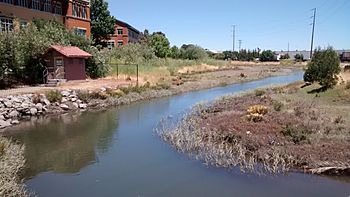San Rafael Creek facts for kids
Quick facts for kids San Rafael Creek |
|
|---|---|
 |
|
| Country | United States |
| State | California |
| Region | Marin County |
| Physical characteristics | |
| Main source | San Rafael, California 37°58′30″N 122°32′18″W / 37.97500°N 122.53833°W |
| River mouth | San Rafael Bay 1.5 mi (2 km) north of San Quentin State Prison 0 ft (0 m) 37°58′2″N 122°29′11″W / 37.96722°N 122.48639°W |
| Length | 3 mi (4.8 km) |
San Rafael Creek is a small waterway located in Marin County, California. It flows into San Rafael Bay, which is a part of the larger San Francisco Bay. The place where the creek meets the bay is like a natural channel through an area with many businesses.
Contents
About San Rafael Creek
San Rafael Creek is about 3 miles (4.8 km) long. It starts in the city of San Rafael, California. The creek then flows east until it reaches San Rafael Bay. This bay is a smaller part of the huge San Francisco Bay.
Keeping the Creek Clean
Unfortunately, San Rafael Creek has faced some pollution problems. In 2007, a group called Save The Bay said it was one of the "worst trash hot spot" waterways. This means a lot of garbage was found flowing into the San Francisco Bay from the creek.
The creek also had issues with a chemical called diazinon. This chemical was a main pollutant affecting many streams that flow into San Pablo Bay. San Pablo Bay is the northern part of San Francisco Bay. Efforts are made to keep the water cleaner now.
Boating on the Creek
The part of San Rafael Creek near its mouth is like a small harbor. It is regularly "dredged," which means the bottom is cleared out. This helps keep the water deep enough for boats to travel through. The material taken from the bottom is then moved to a special site near Alcatraz Island.
What's the Ground Like?
The ground around the lower part of San Rafael Creek is mostly made of clay and "bay mud." This kind of soil does not let water pass through it easily. If you were to dig deep, you would find about four to five feet of soil that was brought in from somewhere else. Below that, there are about 60 to 65 feet (18–20 meters) of soft bay mud. Underneath all of that, you would find solid Sandstone bedrock.
Wildlife at Pickleweed Park
Near the mouth of San Rafael Creek, on its south side, is a place called Pickleweed Park. This park is a great spot to see different kinds of shorebirds. Many birds visit the park, especially during the winter migration season.


